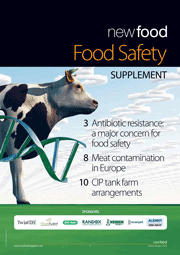Food Safety supplement 2013
- Like
- Digg
- Del
- Tumblr
- VKontakte
- Buffer
- Love This
- Odnoklassniki
- Meneame
- Blogger
- Amazon
- Yahoo Mail
- Gmail
- AOL
- Newsvine
- HackerNews
- Evernote
- MySpace
- Mail.ru
- Viadeo
- Line
- Comments
- Yummly
- SMS
- Viber
- Telegram
- Subscribe
- Skype
- Facebook Messenger
- Kakao
- LiveJournal
- Yammer
- Edgar
- Fintel
- Mix
- Instapaper
- Copy Link
Posted: 22 February 2013 | Dr Hilde Kruse, Helen Bahia, Knuth Lorenzen | No comments yet
Antibiotic resistance: a major concern for food safety (Dr Hilde Kruse, Programme Manager Food Safety, WHO Regional Office for Europe)
Meat contamination in Europe (Helen Bahia, Editor, New Food)
CIP tank farm arrangements (Knuth Lorenzen, EHEDG President)


- Antibiotic resistance: a major concern for food safety
Dr Hilde Kruse, Programme Manager Food Safety, WHO Regional Office for Europe
Antibiotics have revolutionised the treatment of infectious diseases. Unfortunately, their use and misuse have also resulted in the development and spread of antibiotic resistance, which causes treatment failures and consequently more severe and longer-lasting diseases, increased hospitalisation rates, more deaths and higher costs to society. Antibiotic resistance has now become a growing public health problem that requires urgent attention… - Meat contamination in Europe
Helen Bahia, Editor, New Food
On 15 January 2013, the Food Standards Agency (FSA) reported that an analysis carried out by the agency into the authenticity of a number of burger products revealed that some products contained horse and pig DNA. Of the 27 products tested, 10 tested positive for horse DNA and 23 tested positive for pig DNA. Horse DNA was found in low levels in nine of the 10 products, while the last product, frozen burgers from British retailer Tesco, contained approximately 29 per cent horse meat… - CIP tank farm arrangements
Knuth Lorenzen, EHEDG President
A cleaning-in-place (CIP) system can be only as effective as its design, construction, installation and operation. There are a number of opportunities to minimise or eliminate the limitation in today’s CIP systems. One is the engineering of the CIP tank farm and the selection of the equipment in relation to the choice of CIP system on which this article is based. Indeed, there are a lot of other factors to minimise or eliminate the limitation in today’s CIP systems. The most important factor is training and education in hygienic design to all people which are giving input to engineering, executing, operating and maintaining CIP- and food process plants. If all those people are familiar with the relevant food safety legislation, with GMP, HACCP and the hygienic design criteria and its principles. (EHEDG Doc. 8, 9, 10, 13, 14, 16, 17, 18, 20 and 25) and be trained and educated further on human errors can be minimised…
Issue
Related topics
Food Fraud, Food Safety, Hygiene, Mycotoxins, Outbreaks & product recalls
Related organisations
Bio-Rad, Bio-Rad Laboratories, European Hygienic Engineering & Design Group (EHEDG), Food Standards Agency (FSA), Neogen Europe, Randox Food Diagnostics, ToxiMet, TwistDx









